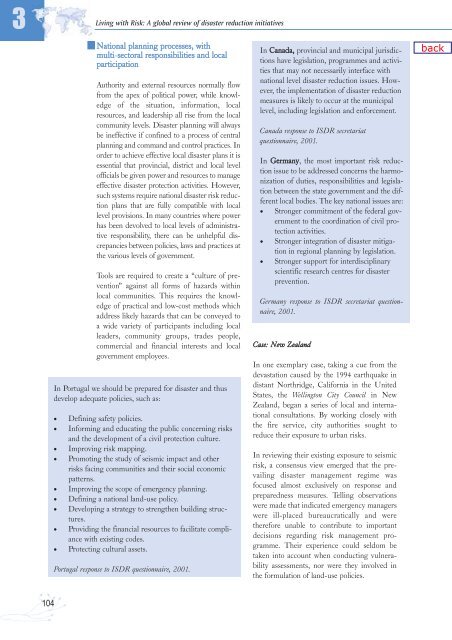Living with Risk. A global review of disaster reduction initiatives
Living with Risk. A global review of disaster reduction initiatives
Living with Risk. A global review of disaster reduction initiatives
You also want an ePaper? Increase the reach of your titles
YUMPU automatically turns print PDFs into web optimized ePapers that Google loves.
3<br />
<strong>Living</strong> <strong>with</strong> <strong>Risk</strong>: A <strong>global</strong> <strong>review</strong> <strong>of</strong> <strong>disaster</strong> <strong>reduction</strong> <strong>initiatives</strong><br />
National planning processes, <strong>with</strong><br />
multi-sectoral responsibilities and local<br />
participation<br />
Authority and external resources normally flow<br />
from the apex <strong>of</strong> political power, while knowledge<br />
<strong>of</strong> the situation, information, local<br />
resources, and leadership all rise from the local<br />
community levels. Disaster planning will always<br />
be ineffective if confined to a process <strong>of</strong> central<br />
planning and command and control practices. In<br />
order to achieve effective local <strong>disaster</strong> plans it is<br />
essential that provincial, district and local level<br />
<strong>of</strong>ficials be given power and resources to manage<br />
effective <strong>disaster</strong> protection activities. However,<br />
such systems require national <strong>disaster</strong> risk <strong>reduction</strong><br />
plans that are fully compatible <strong>with</strong> local<br />
level provisions. In many countries where power<br />
has been devolved to local levels <strong>of</strong> administrative<br />
responsibility, there can be unhelpful discrepancies<br />
between policies, laws and practices at<br />
the various levels <strong>of</strong> government.<br />
Tools are required to create a “culture <strong>of</strong> prevention”<br />
against all forms <strong>of</strong> hazards <strong>with</strong>in<br />
local communities. This requires the knowledge<br />
<strong>of</strong> practical and low-cost methods which<br />
address likely hazards that can be conveyed to<br />
a wide variety <strong>of</strong> participants including local<br />
leaders, community groups, trades people,<br />
commercial and financial interests and local<br />
government employees.<br />
In Portugal we should be prepared for <strong>disaster</strong> and thus<br />
develop adequate policies, such as:<br />
• Defining safety policies.<br />
• Informing and educating the public concerning risks<br />
and the development <strong>of</strong> a civil protection culture.<br />
• Improving risk mapping.<br />
• Promoting the study <strong>of</strong> seismic impact and other<br />
risks facing communities and their social economic<br />
patterns.<br />
• Improving the scope <strong>of</strong> emergency planning.<br />
• Defining a national land-use policy.<br />
• Developing a strategy to strengthen building structures.<br />
• Providing the financial resources to facilitate compliance<br />
<strong>with</strong> existing codes.<br />
• Protecting cultural assets.<br />
Portugal response to ISDR questionnaire, 2001.<br />
In Canada, provincial and municipal jurisdictions<br />
have legislation, programmes and activities<br />
that may not necessarily interface <strong>with</strong><br />
national level <strong>disaster</strong> <strong>reduction</strong> issues. However,<br />
the implementation <strong>of</strong> <strong>disaster</strong> <strong>reduction</strong><br />
measures is likely to occur at the municipal<br />
level, including legislation and enforcement.<br />
Canada response to ISDR secretariat<br />
questionnaire, 2001.<br />
In Germany, the most important risk <strong>reduction</strong><br />
issue to be addressed concerns the harmonization<br />
<strong>of</strong> duties, responsibilities and legislation<br />
between the state government and the different<br />
local bodies. The key national issues are:<br />
• Stronger commitment <strong>of</strong> the federal government<br />
to the coordination <strong>of</strong> civil protection<br />
activities.<br />
• Stronger integration <strong>of</strong> <strong>disaster</strong> mitigation<br />
in regional planning by legislation.<br />
• Stronger support for interdisciplinary<br />
scientific research centres for <strong>disaster</strong><br />
prevention.<br />
Germany response to ISDR secretariat questionnaire,<br />
2001.<br />
Case: New Zealand<br />
In one exemplary case, taking a cue from the<br />
devastation caused by the 1994 earthquake in<br />
distant Northridge, California in the United<br />
States, the Wellington City Council in New<br />
Zealand, began a series <strong>of</strong> local and international<br />
consultations. By working closely <strong>with</strong><br />
the fire service, city authorities sought to<br />
reduce their exposure to urban risks.<br />
In <strong>review</strong>ing their existing exposure to seismic<br />
risk, a consensus view emerged that the prevailing<br />
<strong>disaster</strong> management regime was<br />
focused almost exclusively on response and<br />
preparedness measures. Telling observations<br />
were made that indicated emergency managers<br />
were ill-placed bureaucratically and were<br />
therefore unable to contribute to important<br />
decisions regarding risk management programme.<br />
Their experience could seldom be<br />
taken into account when conducting vulnerability<br />
assessments, nor were they involved in<br />
the formulation <strong>of</strong> land-use policies.<br />
104

















